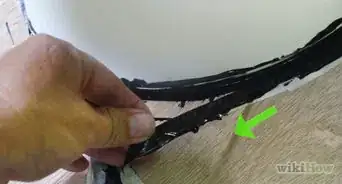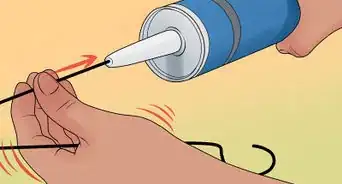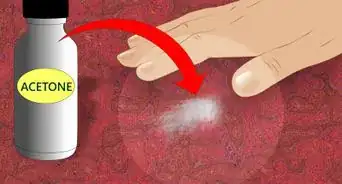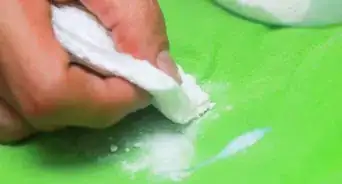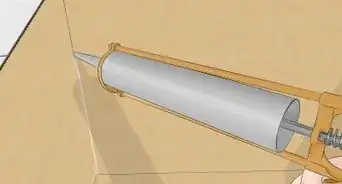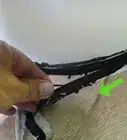This article was co-authored by Art Fricke. Art Fricke is a home renovation and repair specialist and the owner of Art Tile & Renovation based in Austin, Texas. With over 10 years of experience, he specializes in bathroom and kitchen renovations. Art focuses on a single contractor approach to customized renovation work, and performs projects such as installing custom tile showers, fixing tiled shower leaks, replacing cracked tiles, and installing floor and wall tile.
This article has been viewed 134,556 times.
Silicone sealant is a versatile material used in many do-it-yourself projects. If you need to seal a bathtub or a corner, silicone sealant is your best friend. Silicone sealant is similar to caulk, but it’s usually clear or opaque instead of white, and looks more like a gel. It is not sensitive to temperature, and it can withstand all kinds of chemicals, moisture and weathering, making it a great choice for your household needs.[1]
Steps
Utilizing a Silicone Gun
-
1Press down on the gun’s release tab and pull the pressure valve. This is the long, metal plunger in the back, usually underneath the release tab. This will allow you to load the tube of silicone sealant.
-
2Insert the tube of silicone into the gun. Insert it at an angle, base first, and then push it up into the gun. The nozzle of the silicone tube should be sticking out of the opposite end from the release tab and pressure tab.[2]Advertisement
-
3Adjust the trigger so that it is calibrated with the size of your tube. To do this, squeeze the trigger slowly and gently until the mechanism touches the silicone tube. You will then be able to lock the silicone tube firmly in place.
-
4Prepare the surface you wish to seal. Before you apply silicone sealant, make sure that the surface is completely free of any dust, dirt, or particles. Any bits of matter can potentially cause a weaker seal. To prepare your surface:
- Soak a sponge in soapy water and wipe down your surface.
- Rinse out your sponge and use it again to wipe down the area.
- Dry off the area with a towel. Be sure to remove all water completely, as any moisture can cause problems.
-
5Cut a hole in the silicone tube. Snip the tube at a 45 degree angle, and as close to the tip as possible. This will ensure that the hole is very small, making it easier for you to control the flow of sealant.
- You can use either scissors or a utility knife to cut the sealant tube.
-
6Test your silicone on a piece of scrap material. If the sealant is not flowing to your liking, snip a little bit more off of the tube. Gradually cut small bits off until the sealant is flowing at the desired pace.
-
7Apply the sealant to your surface. Squeeze the trigger as evenly and steadily as possible. Drag the tube nozzle slowly along the seam of your project.
- Spread the sealant evenly. Wet your finger, and have a container of water nearby. Use your finger to spread the sealant evenly. Keep getting your finger wet as you work.
- You can also spread the sealant by pressing a piece of masking tape down onto the bead line. Then, pull the tape away before the silicone gets tacky. This should give you a smooth, straight line exactly where you want it to go.[3]
-
8Allow the sealant to dry. While most silicon sealants will feel dry to the touch within 30 minutes to an hour, this does not mean the seal is ready.
- Wait at least 24 hours for the seal to dry before using your project.
- You can try using a fan or a blow dryer on low heat to help the silicone a little faster, but it will still need time to cure.[4]
- You can also purchase a quick-curing silicone caulk. These don't cost any more than other types of silicone caulk, and they'll be water-ready in about 30 minutes.[5]
Using a Can of Sealant
-
1Use a window scraper to remove any unwanted residue. Make sure your surface is absolutely clean so that the sealant will adhere properly.
- If you are resealing surface, the window scraper will help you pull away bits of previous sealant or caulk.[6]
-
2Brush away all dust and debris. A cleaning brush and some paper towels will work for this.
- Make sure that your surface is absolutely dry. Use extra paper towels if necessary.[7]
-
3Cut the tip off of the can of sealant. You can even use your window scraper to do this. Lay it flat on a cutting board and take off the tip at a 45 degree angle.
- If the hole isn’t big enough, you can always cut a little more off later.[8]
-
4Drag the tip of the sealant along the surface of the seam. It’s okay if too much comes out initially. You can neaten this up and wipe off the excess later.[9]
-
5Let the sealant dry. While it may seem to be dry much sooner, it’s best to give it 24 hours to fully set.
How Can I Speed Up Silicone Drying Time?
Expert Q&A
Did you know you can get expert answers for this article?
Unlock expert answers by supporting wikiHow
-
QuestionHow can you make silicone dry faster?
 Art FrickeArt Fricke is a home renovation and repair specialist and the owner of Art Tile & Renovation based in Austin, Texas. With over 10 years of experience, he specializes in bathroom and kitchen renovations. Art focuses on a single contractor approach to customized renovation work, and performs projects such as installing custom tile showers, fixing tiled shower leaks, replacing cracked tiles, and installing floor and wall tile.
Art FrickeArt Fricke is a home renovation and repair specialist and the owner of Art Tile & Renovation based in Austin, Texas. With over 10 years of experience, he specializes in bathroom and kitchen renovations. Art focuses on a single contractor approach to customized renovation work, and performs projects such as installing custom tile showers, fixing tiled shower leaks, replacing cracked tiles, and installing floor and wall tile.
Home Renovation & Repair Specialist
Warnings
- Wash your hands thoroughly after using silicone sealants. Chemicals in some sealants can be toxic.⧼thumbs_response⧽
Things You’ll Need
Utilizing a Silicone Gun
- Silicone sealant
- Silicone gun
- Water
- Scrap material
- Utility knife or scissors
Using a Can of Sealant
- Silicone sealant
- Window Scraper
- Cleaning brush
- Paper towels
References
- ↑ https://www.hotmelt.com/blogs/blog/silicone-sealant-handbook
- ↑ https://www.prettyhandygirl.com/tool-tutorial-friday-how-to-use-a-caulk-gun/
- ↑ Art Fricke. Home Renovation & Repair Specialist. Expert Interview. 14 August 2020.
- ↑ Art Fricke. Home Renovation & Repair Specialist. Expert Interview. 14 August 2020.
- ↑ Art Fricke. Home Renovation & Repair Specialist. Expert Interview. 14 August 2020.
- ↑ https://www.thehairpin.com/2011/08/a-femmes-guide-to-improvement-caulking-your-disgusting-bathroom/
- ↑ https://www.thehairpin.com/2011/08/a-femmes-guide-to-improvement-caulking-your-disgusting-bathroom/
- ↑ https://www.thehairpin.com/2011/08/a-femmes-guide-to-improvement-caulking-your-disgusting-bathroom/
- ↑ https://www.thehairpin.com/2011/08/a-femmes-guide-to-improvement-caulking-your-disgusting-bathroom/
About This Article
Silicone sealant is used in many do-it-yourself projects and is easy to apply. Start by making sure your surface is clean and dry so the sealant will adhere properly. When you’re ready to use your sealant, cut the tip off the can at a 45-degree angle. Then, pull the tip of the sealant along the surface of the seam. Let the sealant dry for a full 24 hours so it fully sets. You can also use a silicone gun to apply your sealant. To load the tube of sealant, press down on the gun’s release tab and pull the pressure valve. Put the sealant in at an angle, making sure the nozzle of the tube is sticking out of the opposite end from the release tab and pressure tab. When you’re ready to apply your sealant, squeeze the trigger as evenly as possible as you drag the nozzle slowly along the seam. To learn how to adjust the trigger of your silicone gun so it’s calibrated with the size of your tube, keep reading!

